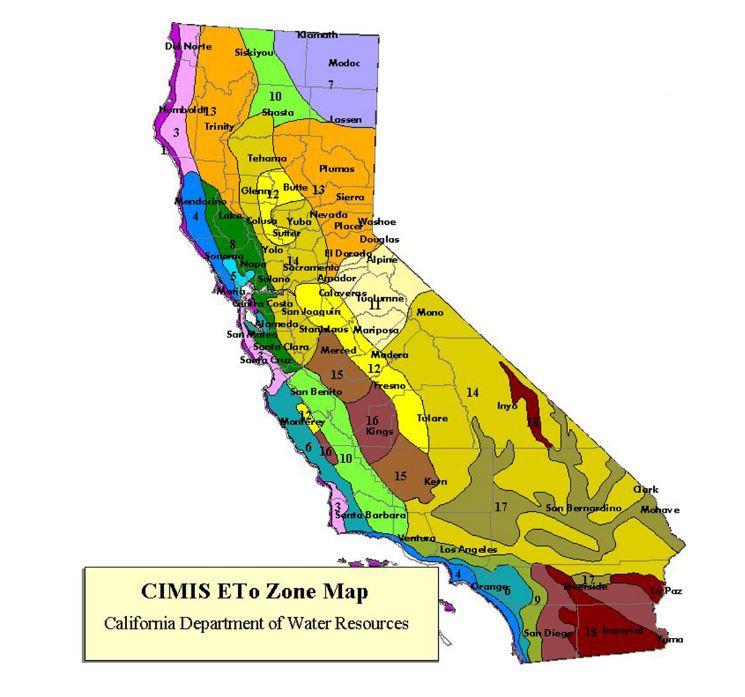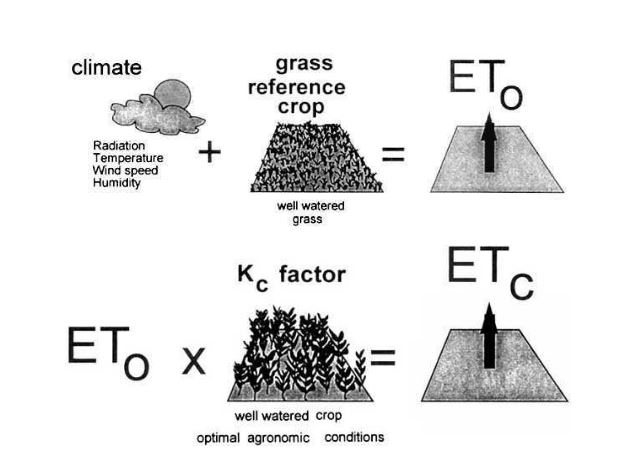By Holloway Ag
Join us for this three-part series on Determining Water Needs for Your Field. As the temps continue to stay high, and many growers enter thier last irrigation cycle of the season, it is especailly important to make sure you are using the right amount of water and that it is working hard for your field. Please enjoy Part 2 and look for Part 3 to be published next week. And check out Part 1 on Evaporation and Transpiration, in case you missed it.
Part 2: Evapotransporation and ETo Zones
How to determine the Evapotransporation and ETo Zones for your particular field.
There are three main factors to understanding how much water you have and how best to use it:
- Plant Physiology Component: Evapotransporation (ET)
- Location Component: ETo Zones
- Crop Component: Acres Inches Needed
What is Evapotranspiration (ET)?
Evaporation and transpiration occur simultaneously and there is no easy way of distinguishing between the two processes. Apart from the water availability in the topsoil, the evaporation from a cropped soil is mainly determined by the solar radiation reaching the soil surface. Solar radiation on soil decreases over the growing period as the crop develops and the crop’s canopy shades more and more of the ground area. When the crop is small, water is predominately lost by soil evaporation, but once the crop is well developed and completely covers the soil, transpiration becomes the main process. At sowing, nearly 100 percent of ET comes from evaporation, while at full crop cover more than 90 percent of ET comes from transpiration.
How to Calculate Your Evapotranspiration
CAL Poly San Luis Obispo created a tool that will do the calculations for your Evapotranspiration. You can access it here. This calculator takes you through a 4-step questionnaire that asks if you are looking to calculate Water Balance or Irrigation Planning and Design. It will then ask you to select an irrigation method and relative precipitation per year, and then finally to select an ETo zone.
ETo Zones
ETo is a climatic parameter and can be computed from weather data. ETo expresses the evaporating power of the atmosphere at a specific location and time of the year and does not consider the crop characteristics and soil factors. This map outlines the ETo Zones in California.

Factors Affecting Evapotranspiration
Weather Parameters
The principal weather parameters affecting evapotranspiration are:
- The sun’s energy
- Air temperature
- Humidity
- Wind speed
Several procedures have been developed to assess the evaporation rate from these four criteria. The evaporation power of the atmosphere is expressed by the reference crop evapotranspiration (ETo). The reference crop evapotranspiration represents the evapotranspiration from a standardized crop surface.
Crop Factors
The crop type, variety and development stage should be considered when assessing the evapotranspiration from crops grown in large, well-managed fields. Differences in resistance to transpiration, crop height, crop roughness, reflection, ground cover and crop rooting characteristics result in different ET levels in different types of crops under identical environmental conditions. Crop evapotranspiration under standard conditions (ETc) refers to the evaporating demand from crops that are grown in large fields under optimum soil water, excellent management and environmental conditions, and achieve full yield under the given climatic conditions.
Management and Environmental Conditions
Factors such as soil salinity, poor land fertility, limited application of fertilizers, the presence of hard or impenetrable soil horizons, a lack of disease and pest control, and poor soil management may limit the crop development and reduce the evapotranspiration.
Other factors to be considered when assessing ET are ground cover, plant density and the soil water content. The effect of soil water content on ET is based on the severity of the lack of water and the type of soil. On the other hand, too much water will result in waterlogging which might damage the root and limit root water uptake by inhibiting respiration.
When assessing the ET rate, management practices should also be evaluated based on how they affect the climate and crop factors within the ET process. Cultivation practices and the irrigation method can alter the microclimate, affect the crop characteristics or affect the wetting of the soil and crop surface. A windbreak reduces wind velocities and decreases the ET rate of the field directly beyond the barrier. The effect can be significant especially in windy, warm and dry environments, although evapotranspiration from the trees themselves may offset any reduction in the field.
Soil evaporation in a young orchard, where trees are widely spaced, can be reduced by using a well-designed drip or trickle irrigation system. The drippers apply water directly to the soil near trees, leaving the major part of the soil surface dry, and limiting evaporation. The use of mulches, especially when the crop is small, is another way of substantially reducing soil evaporation. Anti-transpirants, such as stomata-closing, film-forming or reflecting material reduce the water losses from the crop and the transpiration rate.
Reference (ETo), crop evapotranspiration under standard (ETc)

Coming soon! Part 3 in our series: Determining water in acre inches per crop.
And in case you missed it, read Part 1 on Evaporation and Transpiration – What they are and how they work together to determine your field’s Evapotranspiration (ET).
Join Over 800 Companies Using Holloway Today.
Or Become Part of The Holloway Group to Further Your Career.

